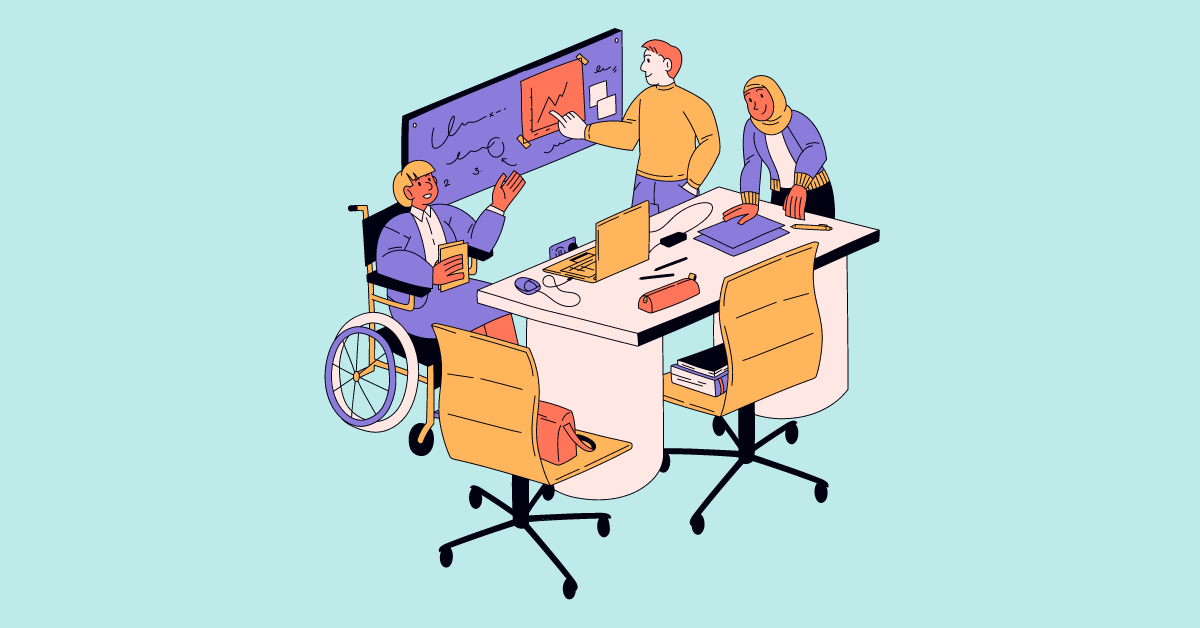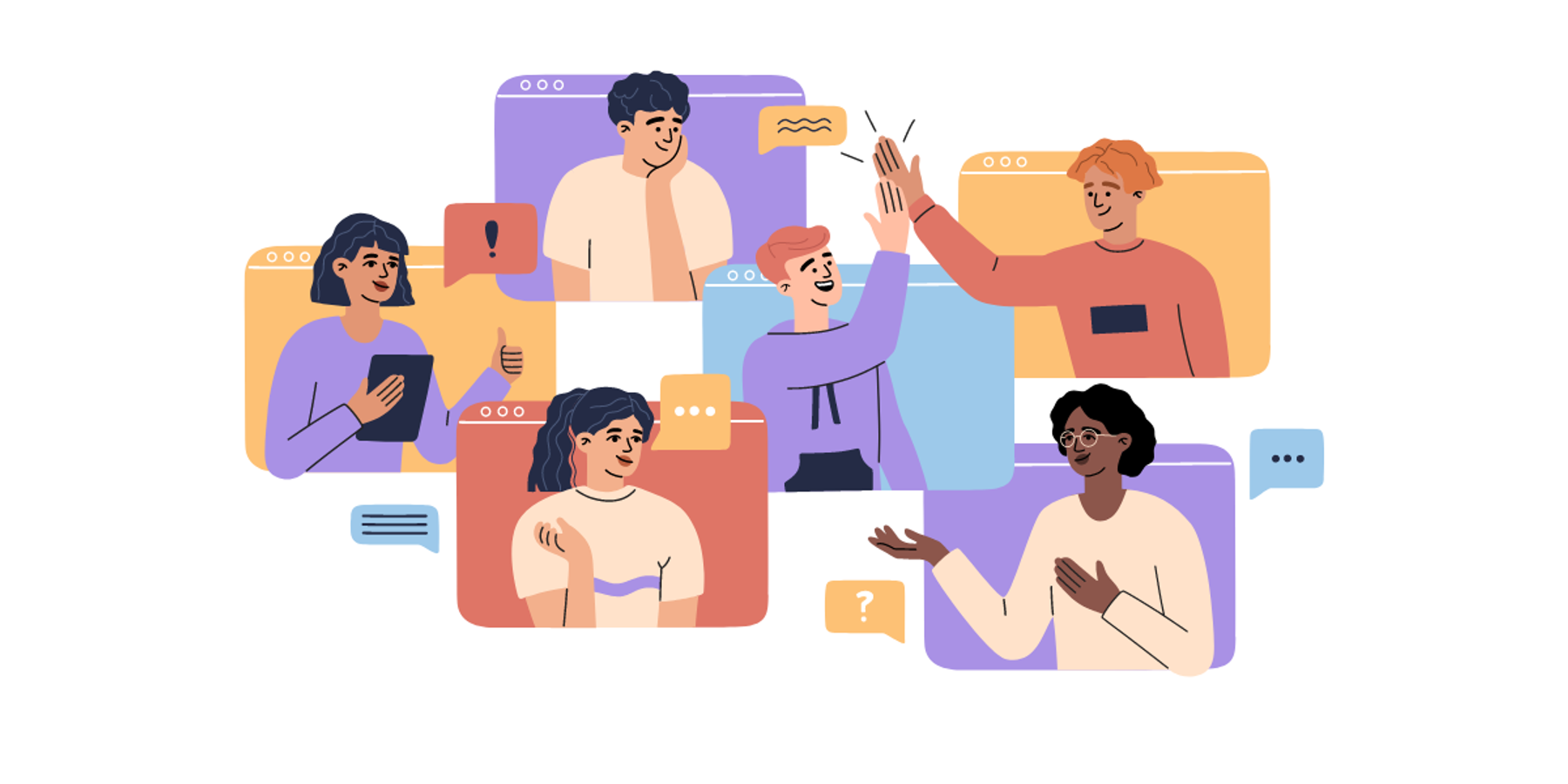Diversity, equity, and inclusion (DEI) in the workplace is the term we apply to the efforts of many organizations to construct a workplace that is more inclusive. Of who exactly? DEI efforts are aimed at being more inclusive of people from different genders, races, ethnicities, sexual orientations, abilities, and religions — especially individuals and communities that have been historically marginalized in professional spaces. Here is a quick guide to diversity, equity, and inclusion (DEI) in the workplace and how you can push for progress at your company.
What is DEI in the workplace?
The phenomenon of professional exclusion is nothing new. So when did DEI in the workplace become such a hot topic? Individuals and communities that experience marginalization in society have always been marginalized in professional spaces. The workplace is, after all, an extension (or a reflection) of society as a whole. It might even be said that the office hierarchy is where our social stratification most visibly plays out.
A global discussion unfolds
The topic of DEI in the workplace was brought to the surface of nearly every workplace environment due to the dynamics of the COVID-19 pandemic response. Certain employees in certain industries were given the option of work-from-home solutions to reduce infection rates. Other employees in other industries were considered “essential workers” and forced to remain at jobs that either interfaced with the public on a daily basis or otherwise gathered people in numbers that went against recommendations from the medical community at the time.
Questions over which roles and industries were adapted for safety, and why these modifications couldn’t be universal or permanent, launched thousands of discussions about exclusions in the workplace — and how we must do better. As companies around the world have adapted, DEI in the workplace remains a substantial priority to both employers and employees.
What is the meaning of diversity, equity, and inclusion? Here, we offer some quick definitions, plus why we actually recommend DEIB initiatives over classic DEI practices.
D - Diversity
A synonym for diversity is variety. In the United States, diversity in the workplace is often associated with race or ethnicity, but that’s not the full story. There are multiple kinds of diversity, including:
- Cultural diversity,
- Racial diversity,
- Diversity of identity,
- Religious diversity,
- Diversity of sexual orientation,
- Gender diversity,
- Intellectual diversity,
- Physical diversity,
- Religious diversity,
- Neurodiversity,
- Socio-economic diversity,
- Linguistic diversity,
- And diversity of nationality.
Our diversity definition includes the full variety of people or groups that exist in a place or an organization, and who bring their unique identities to it. All of these are dimensions that inform how we as people identify, how we’re seen, and how we show up in the world. Ideally, diversity of all dimensions will exist at every level of an organization.
Having a variety of people from different communities and backgrounds is a strength. A lack of diversity leads to discrimination, which has severe impacts on individuals and on society. Research from the Equal Employment Opportunity Commission found that workplace harassment and discrimination is more likely to occur in workplaces where there is a lack of diversity. Plus, a lack of diversity is bad for business. Different backgrounds and thought processes bring innovation to meet the needs of a diverse staff and a diverse customer base.
E - Equity
The definition of equity almost always compares equity vs. equality. Both words are close synonyms that refer to fairness. In the grand scheme of things, equity means the equality of both outcomes and opportunities in a given situation. Equity is the fairness of circumstances as well as resources.
For the specific topic of DEI in the workplace, we often focus on equity of income. Between 1980 and 2016, U.S. income inequality increased by about 20%, according to Pew Research Center. Income equity at a company is the attempt to ensure that U.S. workers like women, Black people, Asians, Latinos, and people in the LGBTQIA+ community are not being paid less than their cis, White, and male counterparts. Beyond income, we also address how people are hired, treated, trained, and promoted in the company.
Special attention is paid to situations where an individual holds multiple identities that have been historically discriminated against in U.S. society. For more about people who face multiple equity concerns, look ahead in this same article to our intersectionality section.
I - Inclusion
What do we mean by inclusion when talking about DEI in the workplace? Inclusion means more than tolerating someone’s presence. Inclusion is the act of creating an environment where any individual or group of people feels respected, supported, and valued.
In a work environment, fostering inclusion applies especially to group discussions and work-related decision making. You may have already guessed, but inclusion doesn’t happen by accident or by default. Since childhood, we all know what it’s like to be left out. Whether it’s a game at recess or a lunch table secret, not being included is a common human experience. In an office setting, inclusion must be worked into the fabric of our workday.
When people are included, they feel free to participate fully. Talent is even attracted (or repelled) by the level of workplace inclusion. An employee study by Deloitte found that:
- 80% said inclusion is important when choosing an employer
- 39% said they would leave their organization for a more inclusive one
- 23% said they have already left a less inclusive workplace
When building intentionally inclusive spaces at the office, we need to ask ourselves questions that affect every level of interaction:
- How can I be a more inclusive individual?
- How can I be more inclusive in my work teams?
- How can the company, as a whole, be more inclusive?
B - Belonging
Belonging puts the ‘B’ in DEIB. Finally, we get to talk about the additional letter that has been added to the discussion of DEI in the workplace.
Classic DEI initiatives covered diversity, equity, and inclusion. If you allow us to get meta for a second, think about who is in charge of those elements in the workplace. Talent acquisition is responsible for diversity. HR is responsible for equity. Managers and leadership are ultimately responsible for inclusion. So, when do we hear from actual employees? And when do we hear from anybody at the entry level for that matter — after all, this is where the reality of company culture lives.
Belonging has entered the chat! A sense of belonging can only be evaluated by an employee. This is the parameter where DEI in the workplace finally addresses stakeholder feedback. Yes, women may be included on the team, but do they feel a sense of belonging? Only the women staffers can answer that question. Belonging is a deeper form of inclusion because it is evaluated by employee experience, not dictated from the top down.
You’ll see us use the terms DEI and DEIB interchangeably here, but the wider conversation is moving in the direction of DEIB as the standard, since belonging is critical to any DEIB strategy.
How important is DEI in the workplace?
Some companies are diverse and inclusive and others are not. So what? Why is DEI important? And how does belonging ultimately affect workplace outcomes? Let’s talk about the real benefits that organizations can realize from inclusion and diversity.
If you’ve spent any time on our blog at all, you know we are often making a business case for DEI in the workplace. Study after study has proven that diverse teams perform better. Despite women and many racial and ethnic groups being underrepresented, gender and racial/ethnic diversity clearly correlate with profitability.
Other benefits of DEI in the workplace
In addition to the bottom line, there are four other areas that benefit from improved diversity and inclusion in a company.
- Driving employee satisfaction: A 2020 McKinsey report on inclusion cites increased employee engagement as a major factor for improved employee productivity.
- Attracting top talent: We already covered that employees self-report on how important diversity and inclusion is when selecting an employer. The 2020 McKinsey report confirms that diversity of talent is a key factor in business performance. We also address this correlation in a separate article on how to retain diverse talent.
- Improving customer insight: Forbes reports that diverse teams and shared values are major ways for companies today to attract new customers.
- Growing your global brand: The MIT Sloan Management Review says diversity and inclusion programs are “essential for building resilient workforces and organizations.” In a world where global crises can affect any part of a supply chain or workforce, the resiliency of a brand lies in its diversity.
As you can see, successful DEI in the workplace has three outcomes: employees feel a sense of belonging, the bottom line improves, and customers believe in the brand. Note how each key aim directly affects overall company performance.
What is an example of DEI at work?
Fostering an inclusive workplace is a high priority for organizations today. It is the main goal of every discussion about DEI in the workplace. So, how do people look for evidence this is happening from the outside?
There are three basics that set the tone for your entire approach to DEI in the workplace. These essentials illustrate DEI best practices when it comes time for potential job candidates, community members, and even competitors to assess your true commitment to DEI.
1. Have a clear vision. In order to track your progress towards greater diversity, equity, inclusion, and belonging, you must have a clear idea of your baseline. From recruitment KPIs to demographics shifts, having a robust data collection system ensures that you can speak accurately about your DEI progress as a company.
2. Maintain transparency. Share your DEI vision openly and often. To start, write a memorable diversity and inclusion statement. Publish it in important spaces for your company and local community.
3. Show progress. If nothing changes, nothing changes. Your C-suite, middle management, and entry-level demographics should not look the same as they did five years ago. Every company must talk about diversity in new ways and take new actions in order to see real progress. The transformation of your company may be fast or slow, but it should be noticeable.
When your company has a clear vision, maintains transparency, and shows progress, you can be sure your DEI strategy is working. How granular should you get? Let’s review what we know about DEI in the workplace when it comes to specific communities.
Focus group: Empowering women in the workplace
Paying people equally for the work that they do, regardless of their gender, has been required by law since the Equal Pay Act was passed in the U.S. in 1963. And yet, women still earn only 83 cents for every $1 that men earn, and are often underpaid even for equal work.
How do women fare with DEI in the workplace? McKinsey in partnership with LeanIn.Org carries out the largest study of women in corporate America. The 2021 Women in the Workplace report found that:
- Though representation of women in the corporate pipeline has improved, women of color in particular remain significantly underrepresented in leadership and face higher inequality as compared with White women and men of color.
- Women are promoted to managerial roles at a rate of 86% compared with their male counterparts.
- Burnout affects women more than men and the pandemic further affected women’s participation in the workforce for multiple reasons, including being the default childcare provider in hetero relationships. In fact, 12 million women left their jobs due to pandemic disruptions.
How do we support women and invest in DEI in the workplace initiatives that benefit them specifically? To start, companies should audit their payroll and implement other practices that ensure equitable promotions and pay raises of female staffers.
All companies in the U.S. hire women. The above focus group is an example of the kind of research your company should do to ensure a successful approach to DEI in the workplace. Similar information for Black Americans, Latinos, Asian Americans, and LGBTQIA+ employees can be found here. Be sure to do your own research to address the diverse communities in your company’s talent pool as needed.
What is intersectionality?
We can’t discuss marginalized groups and DEI in the workplace without mentioning intersectionality. The term “intersectionality” was coined by legal scholar Kimberlé Crenshaw in 1989 to describe the experience of Black women in America.
Intersectionality is the concept that people are affected by multiple systems of power, privilege, and supremacy. Each identity that a person holds can converge and interact when it comes to how they are viewed, treated, and exist in society. For a person who holds a combination of marginalized identities, these “intersecting” centers of power can result in unique and layered experiences of oppression.
For example, intersectionality means that the experience of a Black queer woman at work will be shaped by both her Blackness and queerness, and the intersection of those two things. Her experiences will be different from non-Black queer people as well as from Black straight people.
Be pragmatic and apply this concept. When you do a payroll audit for female staffers, for example, be sure and break out the women of color into subsections. Compare their compensation against each other and their male counterparts. Don’t lump people together by a single identity and make false assumptions.
How do you implement DEI in the workplace?
How can organizations foster an inclusive workplace? Now that we addressed the important issues facing women, let’s move towards progress. How do different industries approach DEI in the workplace? Here are two real life DEI examples.
Online dating industry: Payroll audits
When Mandy Ginsberg took over as CEO of Match Group, operator of dating apps with brands like Tinder, Match, Plenty of Fish, and dozens of others, she vowed to make sure the company was following gender equity lines. Ginsberg hired a third-party to audit the company’s payroll to make sure she was paying women equally. The pleasant surprise? She was. Shocked, she made the auditor double check the results.
She attributes her positive audit results to one of her guiding principles: Her company policy is to offer pay raises based on an employee’s value to the company “whether they ask for it or not.” Harvard Business Review says that while women ask for raises just as often as men, women are less likely to get a yes answer. Merit-based rewards and proactive promotions remove the individual approval factor.
Food & beverage industry: ERGs
Authenticity in the workplace isn’t always easy. It was a long process before Nestlé’s Director of Business Optimization Laurie Bolt felt comfortable bringing her whole self to work. As a wife, mother, and part of the LGBTQIA+ community, Bolt faced pressure to assimilate to traditional gender presentation expectations as well as burnout that led to mental health struggles.
With an international move, Bolt reclaimed power over her work environment. Since her confidence and demeanor recovered, Laurie became an active member of Nestlé’s THRIVE Ability Network, an employee resource group (ERG) that supports teammates through critical illness, invisible disabilities, caregiving, and mental wellness.
When we talk about DEI in the workplace, we often address giving power to employees to have control over their work environments. Psychological safety is a factor of both diversity and belonging. As we discussed, belonging addresses the ability of an employee to have input and feedback that changes real outcomes. The ERG where Bolt now supports other employees’ input is the ideal feedback loop necessary for DEI in the workplace.
Ways for leaders to advance DEI
Knowledge is power. Leaders that educate themselves about DEI in the workplace are already taking the first step. Studying research about the way things have been is the first step towards making progress. This quick guide is an excellent starting point. The next step is to connect with experts on DEI best practices and how best to approach things with your company and the unique issues facing your community. Want to know more about diversity, equity, inclusion, and belonging? Talk about your long-term DEIB strategy with a PowerToFly consultant today.




